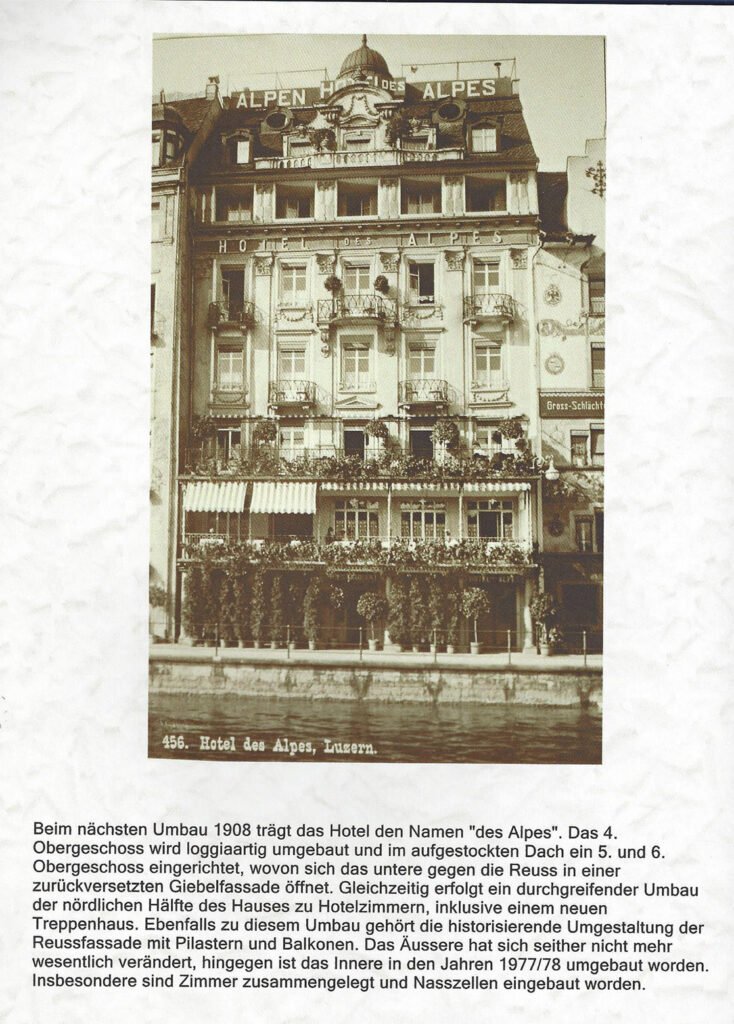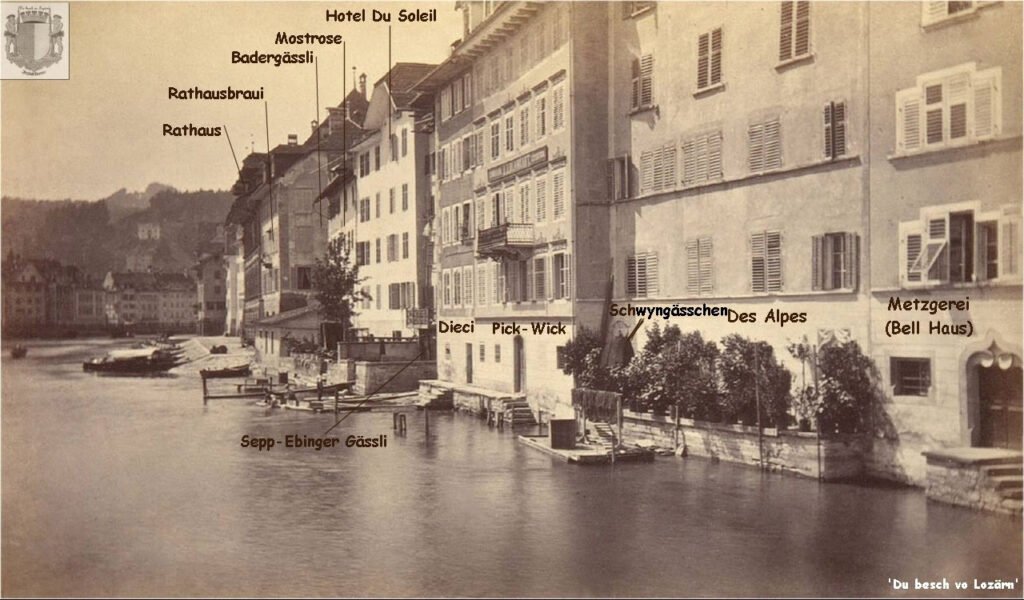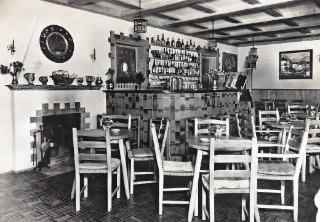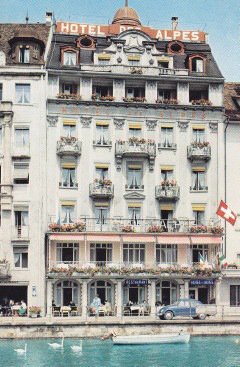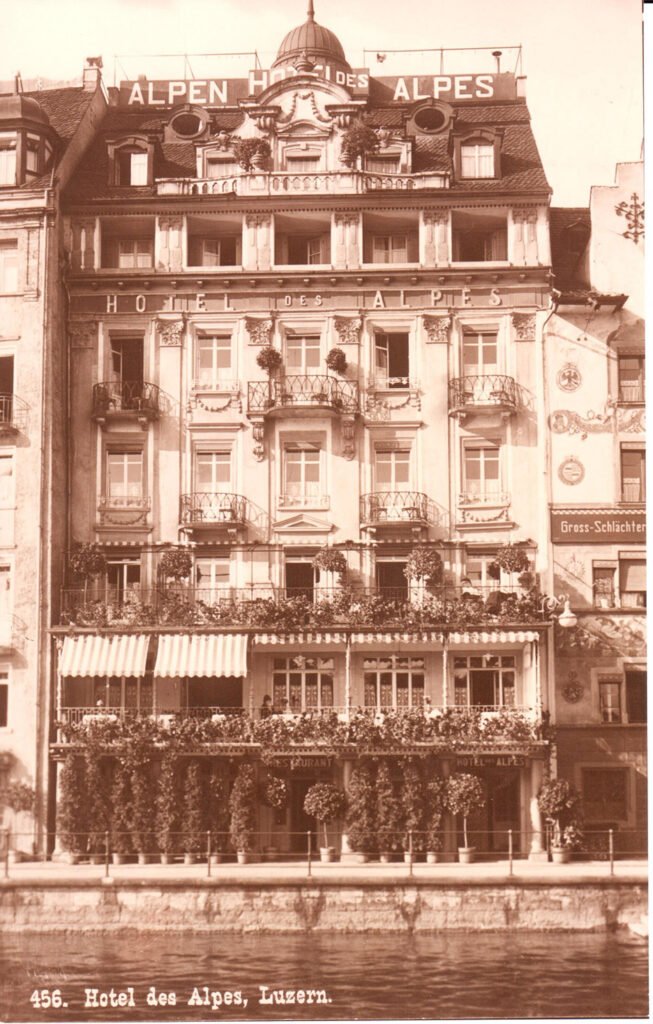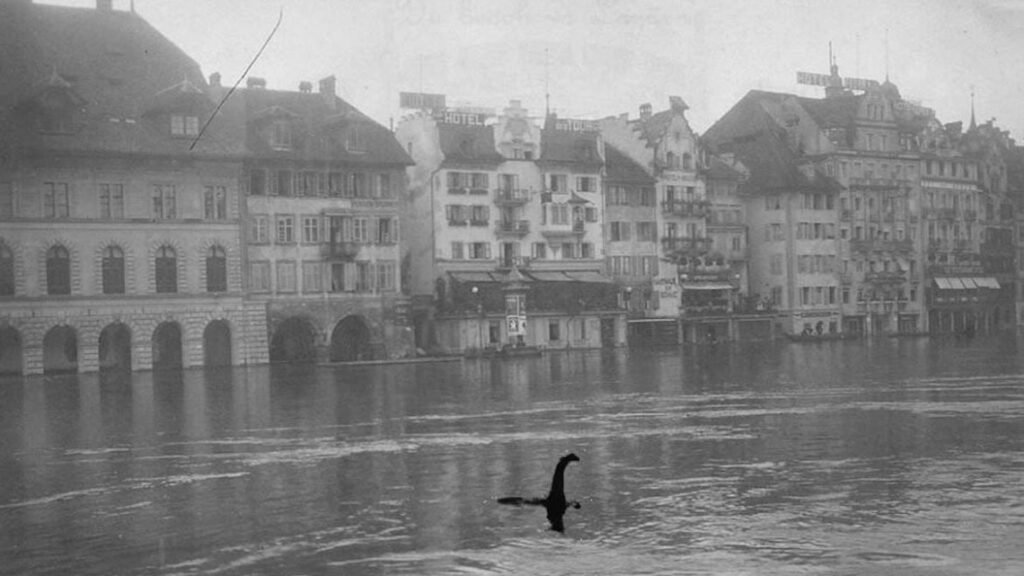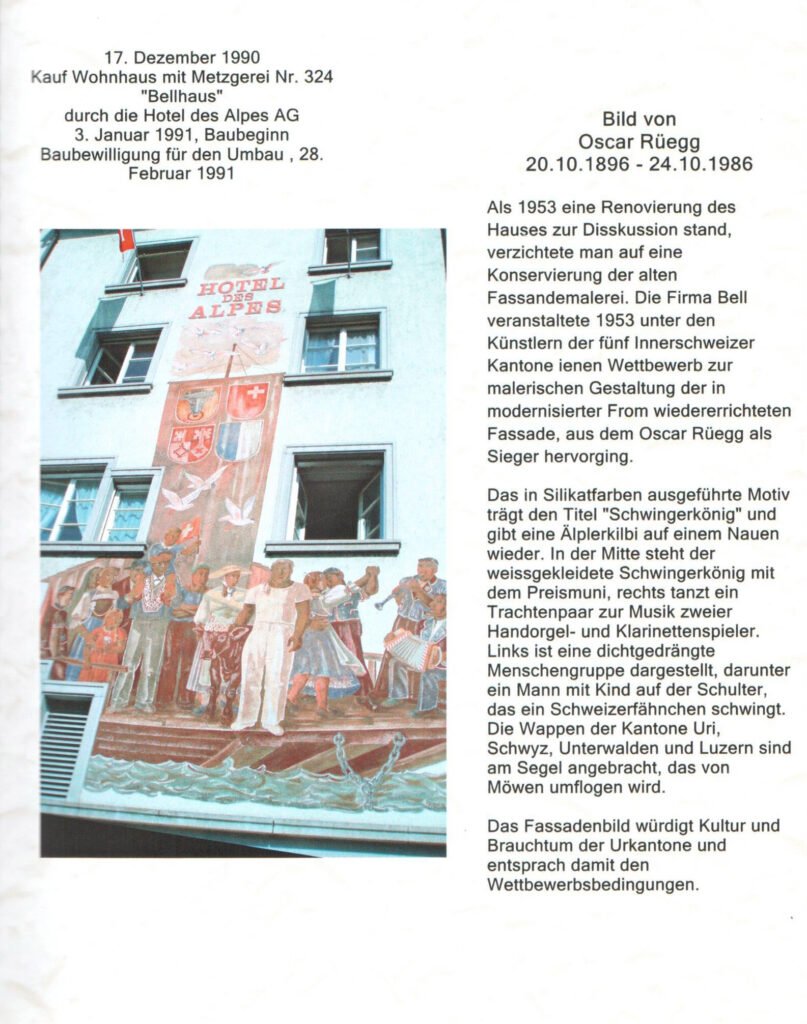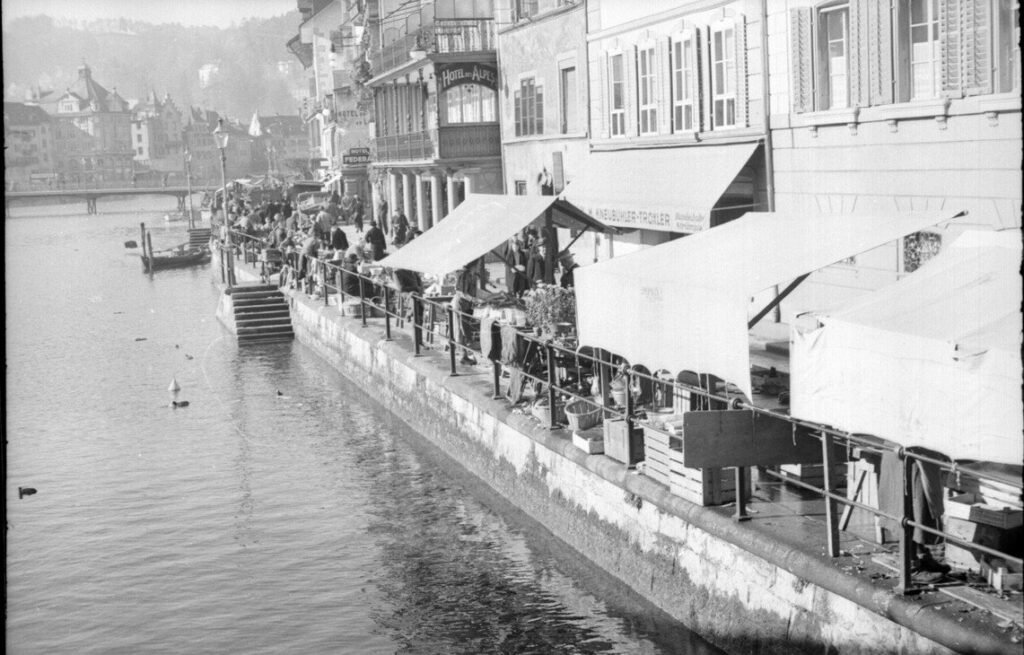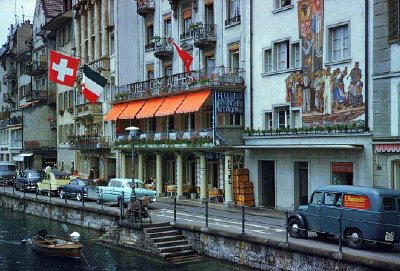The history of an inn and tavern
Thomas Gmür, Lucerne 2001
Building History
The house (cadastral number 325 of the city of Lucerne) was either new or rebuilt by Niklaus Amlehn in 1553. The architect at that time is not known. The house was bordered to the north by Furrengasse, to the south by the Reuss River, to the west by the former “Schwyngässchen” and to the east by house number 324, with which it is connected today. The Gässchen was rather a staircase than a passable way between the two residential houses, the today’s “des Alpes” and the “Mr. Pickwick Pub”, the former Hotel Federal and led directly to the water. According to a servitude, the gate to this staircase had to be open in case of fire danger, which is why the owner of the house No. 328 also had a key to this gate. The Rathausquai did not exist at that time, it was not until 1900 that it was filled in its present form. The residential houses of Furrengasse were situated on the banks of the Reuss. The waste water from the houses flowed directly into the Reuss, which was sometimes an unpleasant sight when the water was deep and sluggish. The main front of the house facing Furrengasse was only slightly altered, but later purified. In 1874/75, when the building was converted into a hotel, the façade facing the Reuss was largely rebuilt. On the one hand, the architect, Albert Meyerhofer, raised the building by one floor, on the other hand, continuous balconies were created on the first floor and on the 1st floor. With these alterations, the architecture followed similar hotel buildings from that time. The competition of the hotel industry was opened on the banks of the river Reuss, to the Schwanenplatz and out to the Palace. The gable construction and the southern-style, loggia-like conversion of the 4th upper floor date from 1908. A next comprehensive intervention was carried out in 1991 by the architects Tüfer + Grüter + Schmid with the push-through of the firewall to the Bell House at Furrengasse 1, which also allowed the hotel to be enlarged. Where the butcher’s shop once was, there is now a restaurant. The firewalls between the two houses could possibly have provided more precise clues to the building history. Still existing fire walls inside the hotel, however, can still provide us with this information.
The conversion into a hotel created two dining rooms on the first floor, which are significant and valuable for the hotel industry of the turn of the century in the city of Lucerne. The first news about the interior of the hotel are tangible only in 1833, when the city ordered to furnish halls and rooms for the city court. The architect at that time was Plazid Segesser von Brunegg. Whether and when court was also held in this building can no longer be determined. Later apartments (for the Schobinger family), hotel rooms, magazine rooms, etc. were freshly built in.
Owner
On St. Martin 1552 Elisabeth Ratzenhofer, daughter and heiress of Niklaus Ratzenhafer, bevogtet by Hans Glesting, sold the house to Niklaus Amlehn. At that time the property consisted of a house, a farmyard and a stable and was located directly next to the new residence of Elisabetha Ratzenhofer. Niklaus Amlehn, the new owner, had the building either reconstructed or rebuilt in 1553. Amlehn was Schultheiss from 1560 to 1566, in 1573 he fled to Unterwalden before a trial, was declared honorless and defenseless and died in 1584 as the last of the regimental Lucerne branch of the Amlehn. In 1676 Dorothea Meyer is recorded as the owner. She had the new gate to the adjacent “Schwyngässchen” built to the west. This alley, probably a staircase, can still be seen on the Martiniplan of 1597. No other owners have survived from this time. Neither sales contracts, nor wills are tangible.
In the 18th century, the respective town clerk lived in this house, so the house seems to have changed at some point into municipal ownership. In 1838, the city sold the house to the corporate municipality, which sold it in 1846 to the Entlebuch master cooper Josef Wicki. Wicki ceded the house to Christian Liechti-Schobinger for the same price just one week later. Probably because Liechti was a reformed Bernese, Wicki acted as a straw man. From the heirs of Christian Liechti, the house passed to the Lucerne merchant Ignaz Minder in 1850. In 1878, the wine merchant Heinrich Schobinger-Gloggner bought the property from the bankruptcy estate of Ignaz Minder for himself and his family as a residence. From 1878 to 1882, Joseph Anton Schobinger (1849-1911), Federal Councillor from 1908 to 1911, also lived in this house. In 1907, the house, now mutated into the Hotel des Alpes, changed hands again. From the possession of the brothers Joseph Anton and Albert Schobinger, the house now passed into the hands of Caspar Troxler, innkeeper of the Hotel des Alpes since 1901. In 1922 Emil Troxler inherited the hotel. From his heirs it came for a short time into the possession of the Swiss People’s Bank, before the hotelier August von Holzen bought it in 1943. From 1950/51 Werner Durrer (1885-1958) acted as owner of the hotel. His heirs control the current owner, Hotel des Alpes AG.
City Clerk’s Office
.
The town clerk’s office was originally, i.e. from the early 15th century, housed in the Klauserhaus (Metzgerrainle 9), next to the old town hall, where the Hotel des Balances or Hotel zur Waage is located today. Earlier records of the location of the town hall or the town clerk’s office are not known. With the construction of a granary and department store on the Kornmarkt, the town clerk’s office also moved to these new buildings, which housed the town hall from about 1460. This first town hall at the Kornmarkt was then replaced by a new building in 1602. In the 18th century, the house at Furrengasse 3 is mentioned as the town clerk’s office, before the town hall was moved to the Graben for a short time. Today, the City Chancellery is housed in the town house on Hirschengraben.
The town clerk’s office included several offices, but which ones were really carried out in the house on Furrengasse is unclear. The town clerk was an office that was highly respected in Old Lucerne. As a neutral person, he was not allowed to hold any other political office. Originally, this office was held by a monk or cleric. As Lucerne grew, it now also needed a permanent scribe. From the 15th century onwards, the city had a permanent secular scribe. Since Lucerne was a city-state until 1798, the scribe functioned as a state scribe, especially in the 18th century. In 1427 a scribe is mentioned for the first time, to relieve the city scribe. Later, a council substitute or council scribe was called in to take down the minutes at council meetings. In order to better control the chief clerks, the council introduced a bailiff clerk in 1595, who in the future rode along with the bailiffs, so that the town clerk could devote more time to the council clerkship. However, there were other officials working in the town chancellery. The house on Furrengasse, however, seems to be too small to accommodate the entire chancellery. It can be assumed that only the chief clerk lived in the house and did his work. In the 18. Century the following Stadtschreiber are delivered to us, who possibly inhabited the house at the Rathausquai:
- 1706-1712 – Jost Bernhard Hartmann (1685-1752), Kleinrat, Schultheiss
- 1712-1722 – Anton Leodegar Keller (1673-1752), Kleinrat, Landschreiber zu Locamo
- 1723-1727 – Franz Urs Balthasar (1689-1763), Kleinrat, builder, founder of the Helvetic Society
- 1728-1750 – Josef Anton Leodegar Keller (1697-1782), Kleinrat, Pannerherr, Schultheiss
- 1751-1766 – Johann Martin Franz Anton Keller (1703-1766), Swiss Guardsman, Colonel in Savoy
- 1766-1789 – Karl Martin Keller ( + 1789), Vogt zu Mendrisio
- 1789-1798 – Alphons Josef Alois Johann Baptist Pfyffer von Heidegg (1753-1822), member of the Helvetic Directory, Grassrat
Hotel
In 1874/75, the Lucerne merchant lgnaz Minder converted the residential building into a hotel. But the time as a hotel was only short, because already in 1878 Minder went bankrupt. The hotel and cafe Minder closed. From 1878 to 1882 there is then evidence of the Spanish Wine Hall, and from 1882 a Bavarian Beer Hall in the premises of the inn. It is not certain whether the wine merchant Heinrich Schobinger also ran the inn himself in the meantime. In any case, the family used the building as a residence. Shortly before the turn of the century, the house housed the Cafe du Pont, before it mutated into today’s Hotel des Alpes in 1901. The house received its innkeeping rights from the former “Taverne zum Stein”. This tavern on Schwanenplatz (corner of Wagenbachgasse) was run by Josef Alois Siegwart; he renamed his tavern “Des Alpes” before emigrating to America in 1872 after a bankruptcy. After that, this tavern changed hands several times before it had to make way for the new building by Goldsmith Bossard in 1899. The name of the house and the passage to the stone still remind us of the old tavern on Schwanenplatz. Originally, the tavern Zum Stein stood on Franziskanerplatz, where the Finance Department now stands. A first mention of this wine tavern dates back to 1522.
With the opening of the Hotel des Alpes in 1901, the tourist core of the large hotels on Schweizerhof- and Nationalquai expanded into Lucerne’s old town. Several smaller hotels and guesthouses, which took advantage of the flourishing tourism at the turn of the century, are signs of this. Other hotels have a more checkered history in the 20th century than the Hotel des Alpes, which has now been in operation as an inn for a hundred years and still serves tourism and tourism.

